Coconut is a versatile fruit grown in tropical regions and widely used in both culinary and cosmetic fields. Botanically known as “Cocos nucifera,” this plant is divided into various species and subspecies around the world according to different climate conditions and usage purposes. Especially in countries in Asia, Africa, and Latin America, coconut is an important economic product, offering diverse uses through its oil, milk, water, and fiber. Therefore, in terms of agricultural production, classifying the varieties according to different productivity, disease resistance, and usage types is of great importance.
In general, coconuts are classified into three main groups: “Tall,” “Dwarf,” and “Hybrid.” Each group differs in criteria such as growth period, fruit-bearing age, and the quality of water and flesh. For example, dwarf types are notable for bearing fruit early, while tall types have a longer lifespan and can produce larger fruits. In recent years, in addition to traditional types, varieties like King Coconut and Macapuno, which have special taste and texture characteristics, have also gained popularity. This diversity offers a wide range of options for both agricultural producers and consumers.
What are the types of coconut?
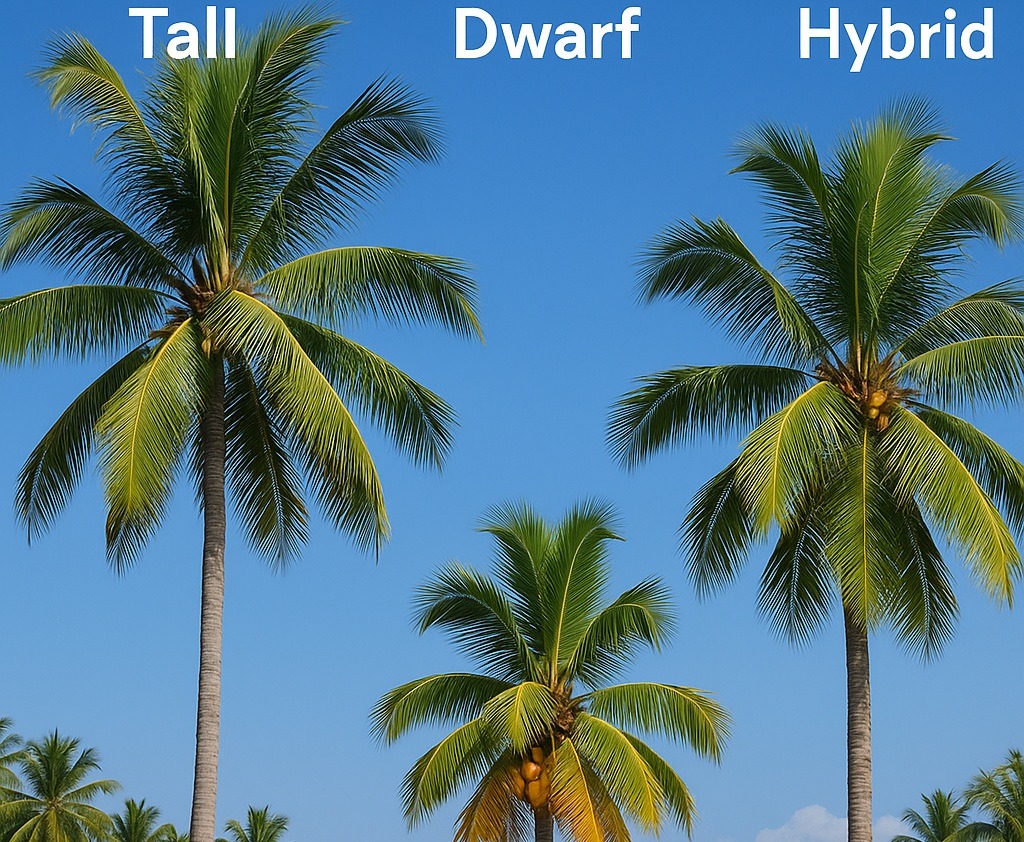
Coconut varieties are generally divided into three main groups: Tall, Dwarf, and Hybrid. Tall varieties usually grow through natural pollination and can reach heights of up to 20 meters. These types have a longer fruit-bearing period (approximately 6–8 years) but also have a longer lifespan and can provide high yields. Examples of this group include West African Tall, Jamaican Tall, Panama Tall, and Sri Lankan Tall. These varieties are commonly preferred for both their flesh and milk.
Dwarf varieties, on the other hand, bear fruit in a shorter period of about 3–4 years and are shorter in height (approximately 6–8 meters), making them easier to maintain and harvest. Malayan Dwarf, Fiji Dwarf, and King Coconut, which are especially preferred for drinking water production, belong to this group. The third group, Hybrid coconuts, is obtained by crossbreeding Tall and Dwarf varieties. These types offer advantages such as fast fruit-bearing, high yield, and resistance to diseases. The most common hybrids include Dwarf × Tall (DxT) and Tall × Dwarf (TxD) combinations. Hybrid types are widely preferred in both commercial production and industrial use.
What are the differences between Tall and Dwarf coconuts?
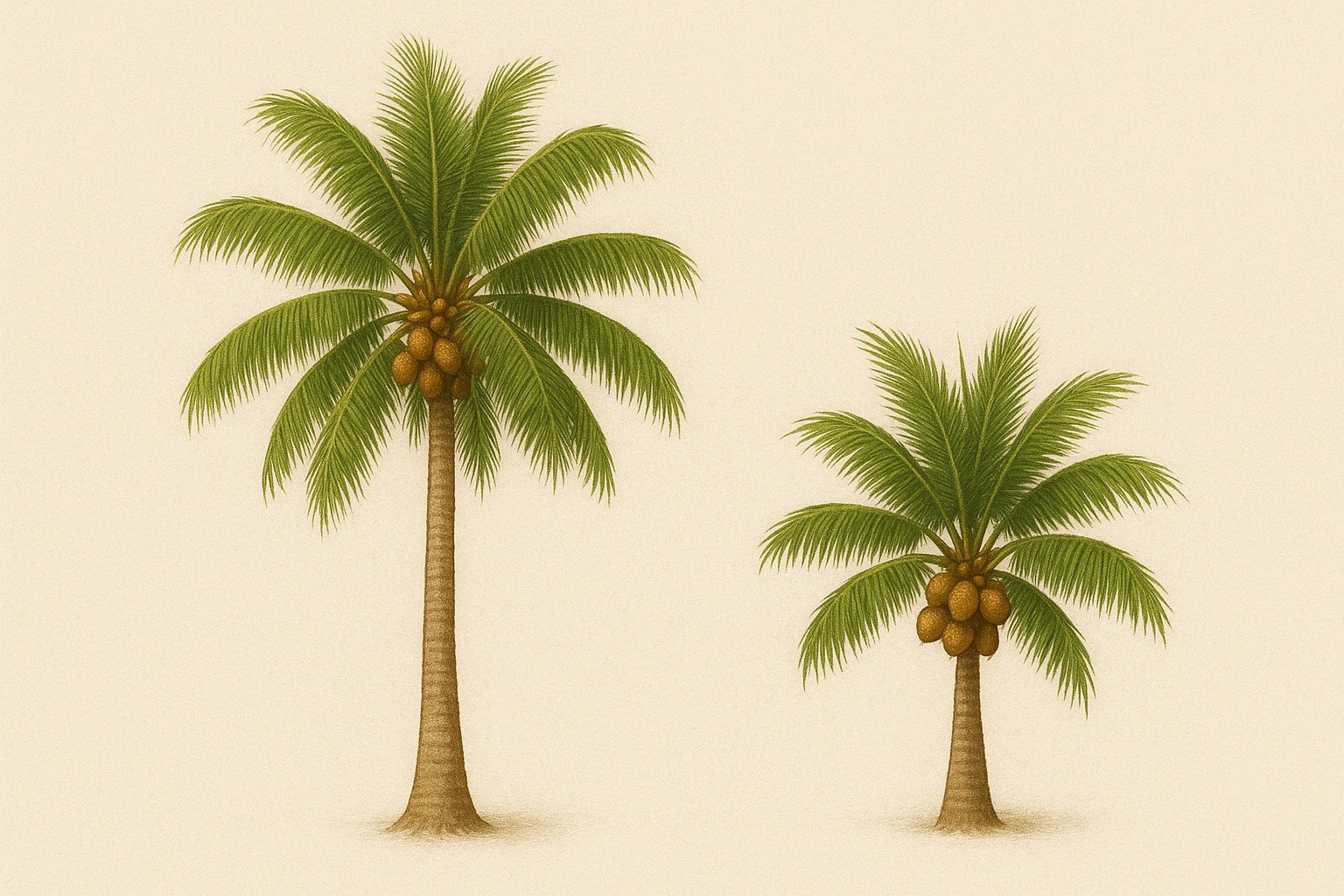
The main differences between Tall and Dwarf coconut varieties relate to their growth patterns, fruit-bearing times, productivity, and environmental resistance. Tall types are typically tall trees that can grow up to 20 meters and reproduce through natural cross-pollination. These types begin to bear fruit in about 6–8 years and are known for their long lifespan (approximately 60–80 years). Their high productivity and large fruit size make them especially preferred in commercial cultivation. They are also more resistant to drought and salinity.
Dwarf types, as the name suggests, are shorter (usually 6–8 meters) and are generally self-pollinating. They begin to bear fruit in approximately 3–4 years, making them ideal for those seeking faster production. However, their lifespan is usually shorter than Tall types (about 30–40 years). Dwarf coconuts are especially known for their high-quality drinking water and are often used in drink-focused varieties like King Coconut. Dwarf types are easier to maintain and harvest, offering a practical advantage for small-scale producers.
What are the Hybrid coconut varieties and what are their advantages?
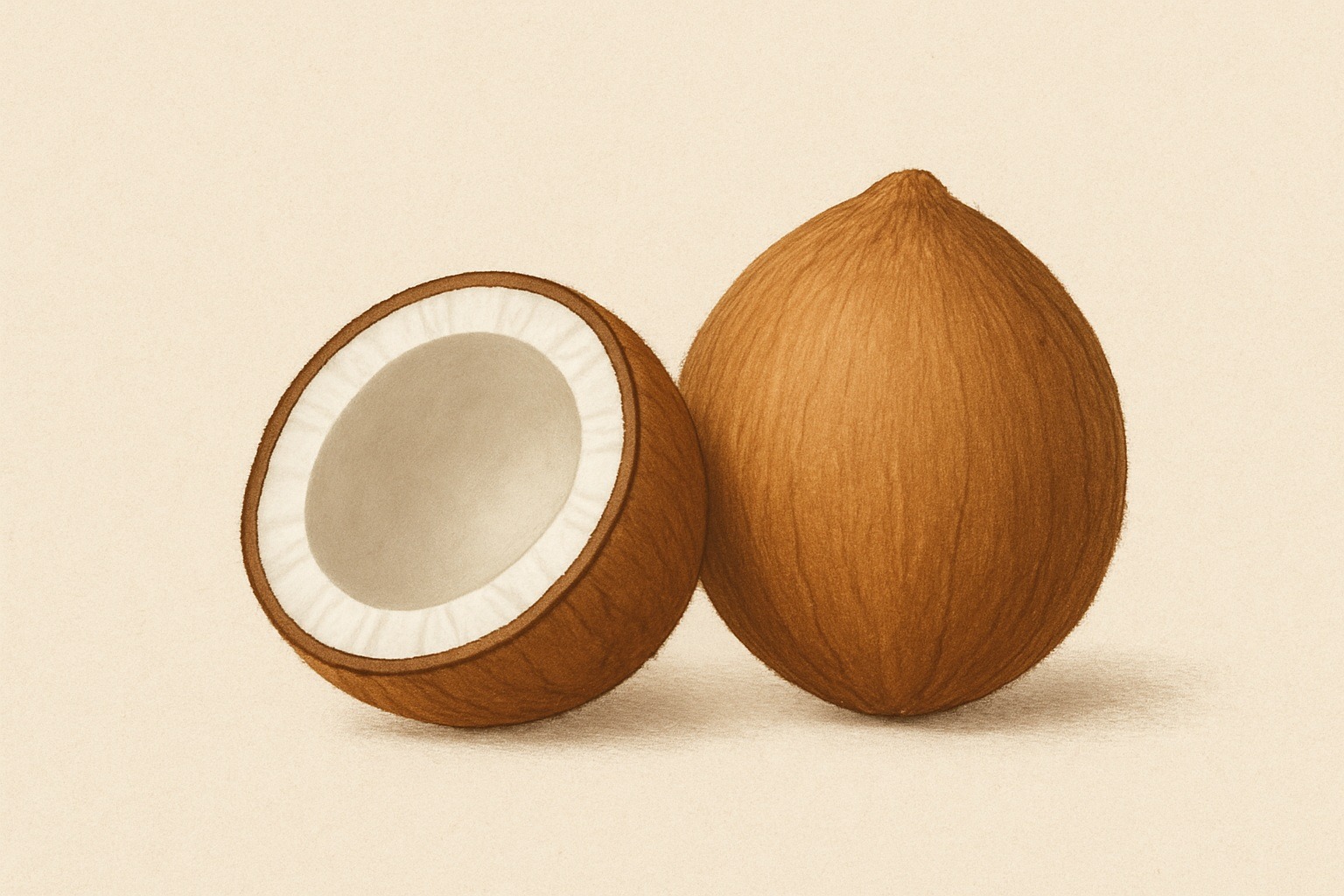
Hybrid coconut varieties are special types obtained by crossbreeding Tall and Dwarf varieties, possessing superior characteristics in terms of both productivity and resilience. The most common forms of this crossbreeding are Dwarf × Tall (DxT) and Tall × Dwarf (TxD) combinations. For example, pairings like Malayan Dwarf × West African Tall are preferred for providing both early fruit-bearing and high yield. Hybrid types are specially produced through controlled pollination and are grown under specific conditions for genetic stability.
The biggest advantage of hybrid coconuts is that they combine the strengths of two different types. The early fruit-bearing trait of Dwarf varieties and the long-living, durable structure of Tall varieties are brought together in hybrid types. In addition, many hybrid varieties are developed to be more resistant to pests and diseases. Due to advantages such as high water and flesh yield, regular fruit production, and efficient cultivation on a commercial scale, they are especially preferred in large-scale agricultural projects. Hybrid types hold great economic importance for both the food industry and cosmetic production.
What is King Coconut, and what are its characteristics?
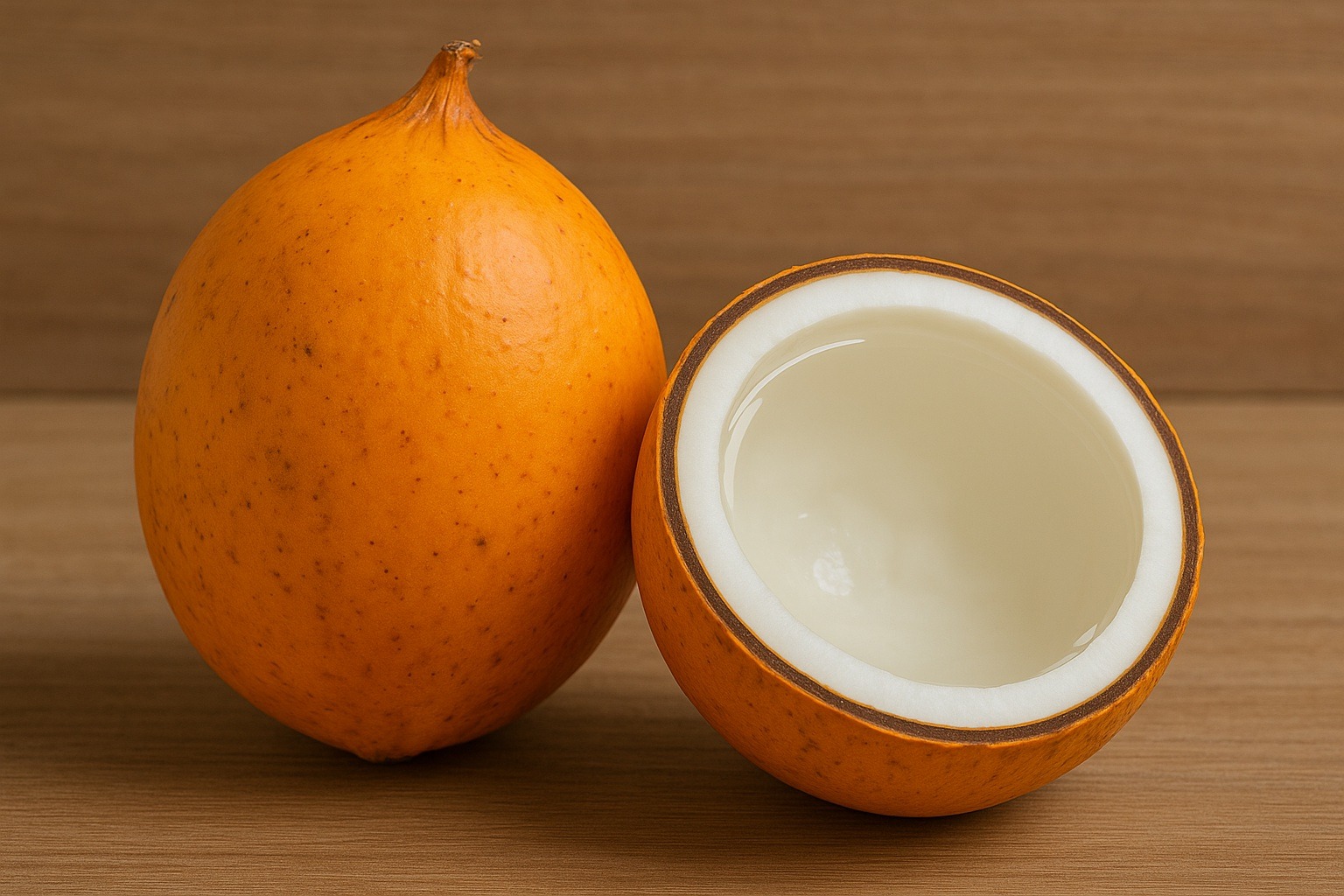
King Coconut is a variety of coconut that originates especially from Sri Lanka and is specifically cultivated for its drinking water. Botanically classified as Cocos nucifera var. aurantiaca, this type is easily distinguished from other coconut varieties by its bright orange-brown shell. These trees, generally classified under the Dwarf category, begin to bear fruit in as little as 3 to 4 years and do not grow very tall. King Coconut is predominantly grown in hot and humid tropical climates, especially in the western and southern regions of Sri Lanka.
The most notable feature of this variety is the clear, mildly sweet, and mineral-rich water found inside its fruit, which is extremely refreshing and healthy. Due to its low fat content and high potassium level, King Coconut water is a natural source of electrolytes. For this reason, it is widely consumed in hot climates to relieve thirst and maintain body balance. It is usually drunk fresh directly from the shell and is commonly offered by street vendors in Sri Lanka. The flesh of this variety is thinner compared to other coconuts, and water consumption is the primary focus.
What is Macapuno (kopyor) coconut?
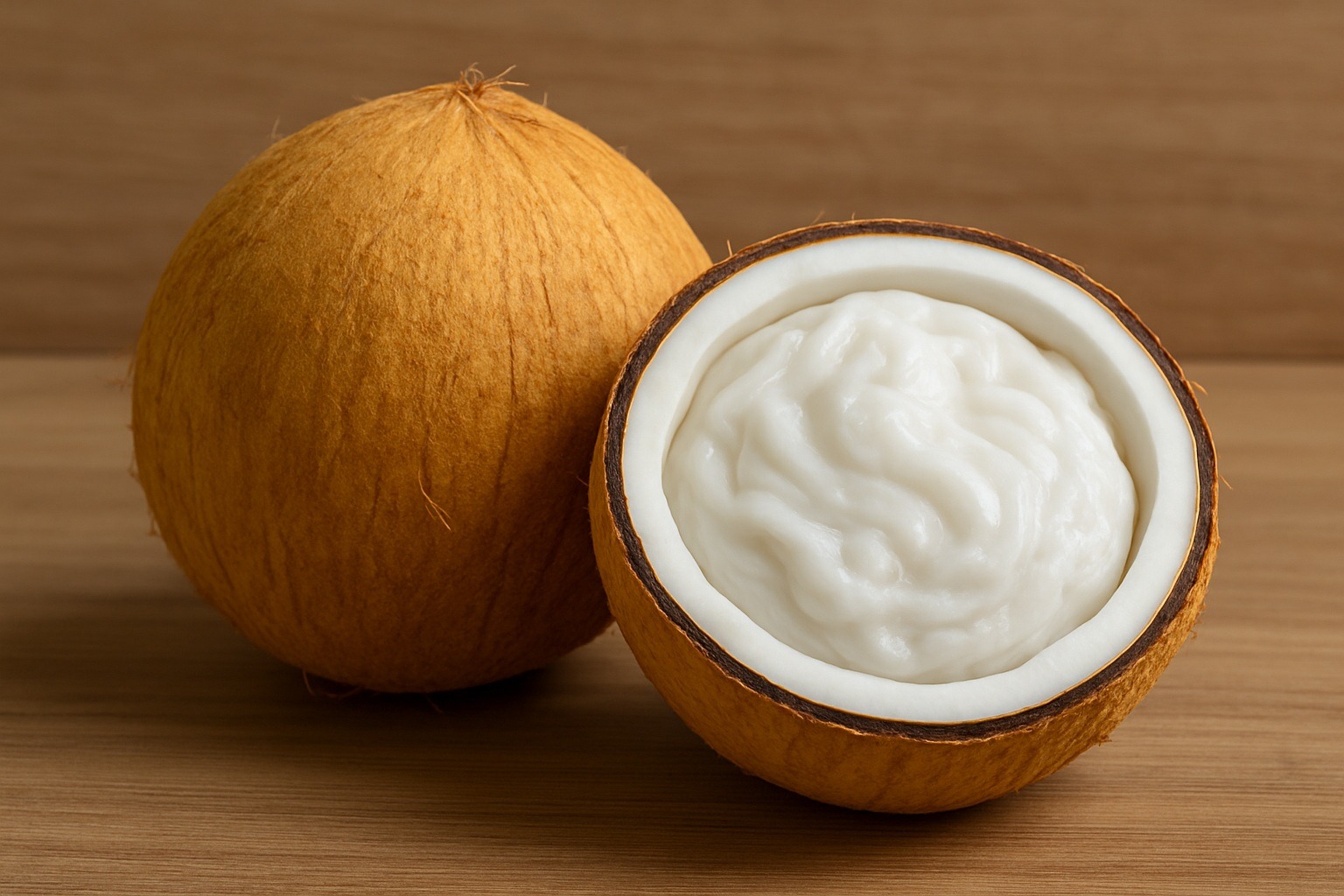
Macapuno (or Kopyor, as it is known in Indonesia) is a special variety of coconut that results from a genetic mutation and has a structure different from traditional coconut types. It is commonly found in Southeast Asian countries such as the Philippines, Indonesia, and Thailand. In this type, the normally liquid coconut water largely solidifies into a gel-like form, creating a thick and soft flesh texture. This flesh is sweeter and denser compared to regular coconuts.
Macapuno coconut is widely used especially in dessert making. It frequently appears in Filipino cuisine in ice cream, jams, cakes, and other sweets. Unlike standard coconuts, this type cannot grow on its own; specially developed Macapuno trees are required for its reproduction. Additionally, Macapuno is more expensive and rarer than regular coconuts. Due to its rich texture and unique aroma, it has become a favored flavor in gourmet and specialty food products.
What are the characteristics of dwarf varieties such as Fiji Dwarf and Malayan Dwarf?

Fiji Dwarf and Malayan Dwarf are dwarf coconut varieties that are widely cultivated around the world and are especially preferred for drinking water production. The biggest advantage of these types is that they begin to bear fruit in a short period of 3–4 years. Additionally, since their height usually ranges between 6–8 meters, maintenance, pruning, and harvesting processes can be carried out easily. Because of these features, they are preferred by both small-scale farmers and large plantations. They are also suitable for dense planting practices, especially in tropical regions.
Malayan Dwarf has three main color variants: green, yellow, and reddish-orange, and it is a highly productive variety. Fiji Dwarf is known for its high resistance to diseases, especially lethal yellowing disease, and its durable structure allows for long-term production. The water of these varieties is generally sweet and refreshing; their flesh is also soft and suitable for consumption. Since dwarf varieties have ideal features for both fresh consumption and commercial beverage production, they continue to maintain their popularity worldwide.
When do Tall varieties bear fruit, and what is their fruiting onset period?
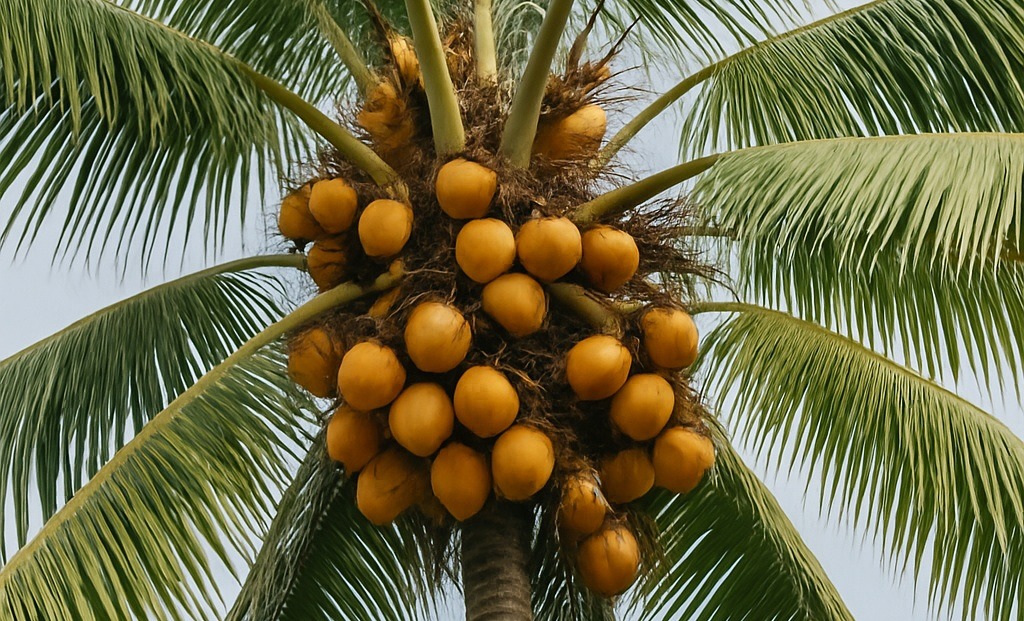
Tall coconut varieties are generally types that grow through natural pollination and have a slow growth process. These trees usually begin to bear fruit within 6 to 8 years. Since root development and trunk elongation are prioritized in the early years, fruit formation occurs later compared to dwarf types. However, once they begin to bear fruit, they can produce regularly and abundantly for many years. Their lifespan typically ranges between 60 and 80 years, making them suitable for long-term cultivation.
These types yield better results in fertile soils and tropical climate conditions. Although their height can reach up to 20 meters—making the harvesting process more difficult—they offer high yield potential with their broad leaves and large fruits. Due to the long time required for fruiting, they are generally preferred in large-scale agricultural projects that require patience and long-term investment. Thanks to their durability and adaptability, Tall varieties are widely cultivated especially in areas close to salty water or in drought-resistant agricultural zones.
How are coconut hybrids (DxT vs TxD) produced, and what are their advantages?
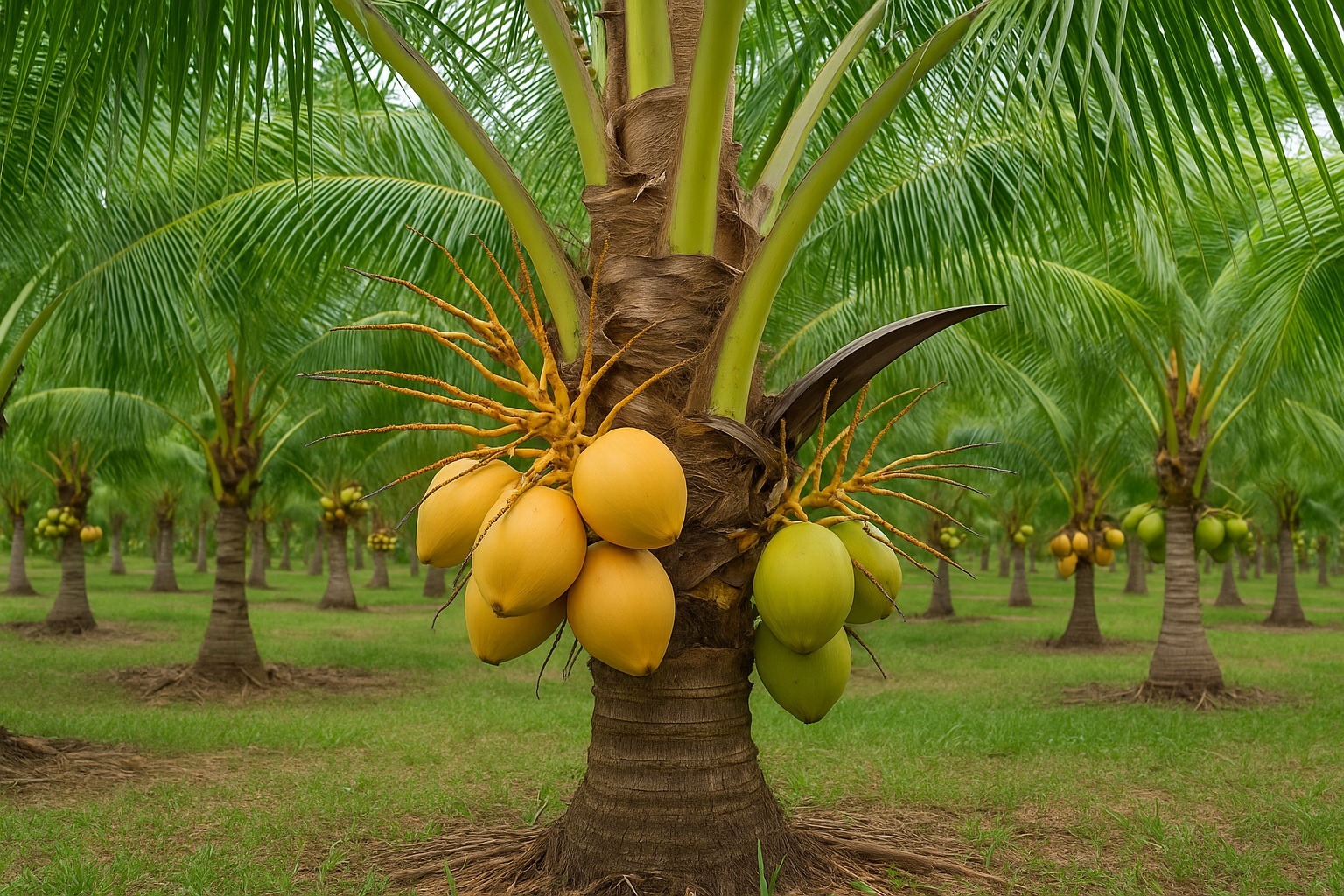
Coconut hybrids are produced by crossbreeding Dwarf and Tall types that have different characteristics. Two main combinations stand out in this hybridization: DxT (Dwarf × Tall) and TxD (Tall × Dwarf). In DxT hybrids, the Dwarf type is used as the female parent, and the Tall type as the male pollen source; this combination is generally preferred to obtain individuals that bear fruit early but also have high yield. In TxD hybrids, the Tall is the female and the Dwarf is the male, but this combination requires more complex production processes. Both types are developed in seedling production centers through carefully controlled pollination procedures.
The main advantage of these hybrids is that they combine the positive traits of both parent types. For example, the early fruiting ability of Dwarf types and the long lifespan and high yield of Tall types are combined in hybrids. Additionally, many DxT hybrid varieties are more resistant to pests and diseases and provide consistent fruit production. Hybrid coconuts are ideal for stable and high-quality production that delivers high yield in a shorter time. Therefore, they are widely preferred in commercial plantations and sustainable agriculture projects.
Which variety has the sweetest/purest drinking water?
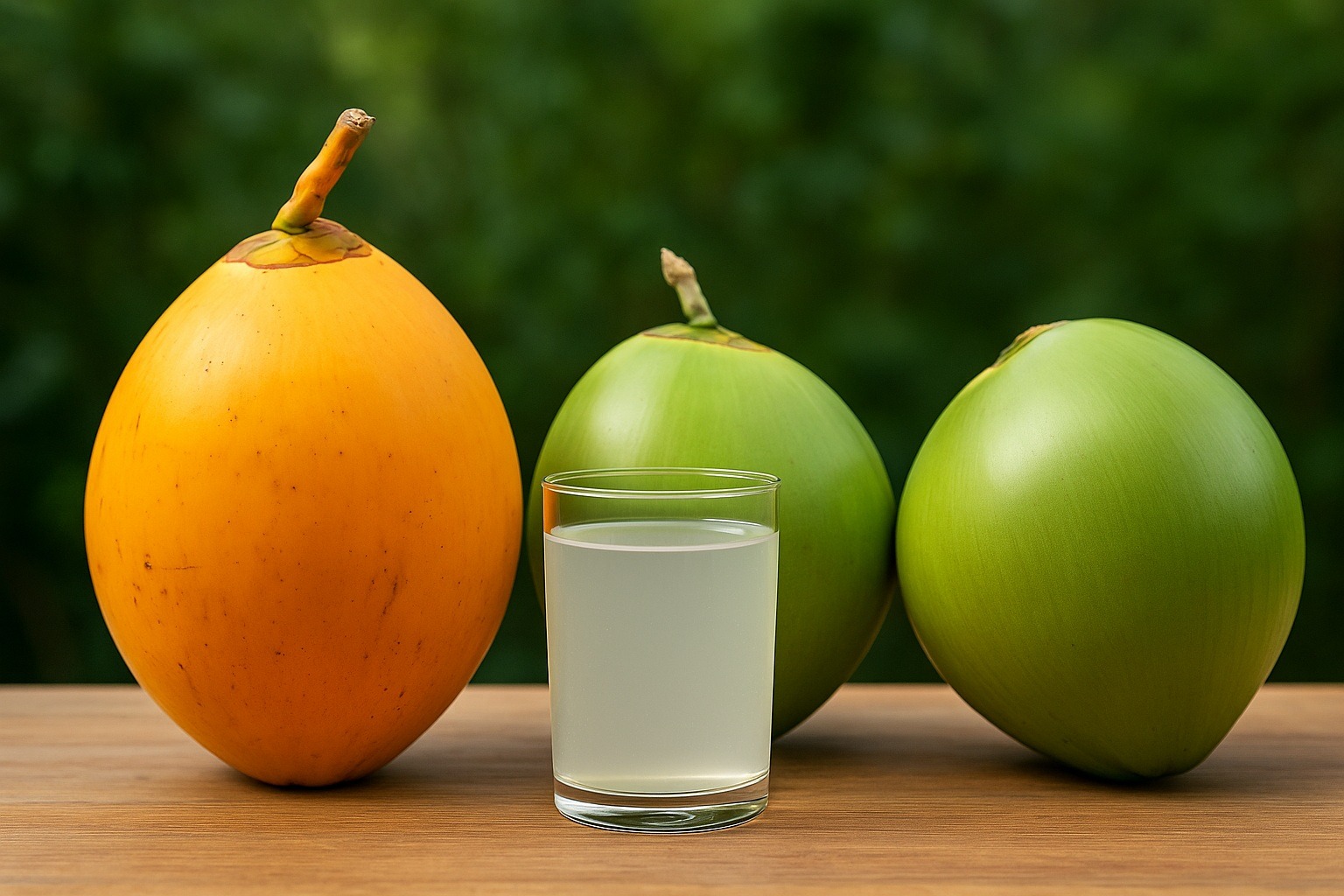
Among coconut types, King Coconut and certain Dwarf varieties offer the sweetest and purest drinking water experience. Especially King Coconut, which originates from Sri Lanka, is a special variety cultivated solely for drinking water production. This coconut is known for its mildly sweet, clear, and refreshing water. Rich in natural electrolytes (especially potassium), it offers a health-beneficial and cooling beverage option. Freshly served on the streets in Sri Lanka, King Coconut is highly valued for quenching thirst and maintaining body balance.
In addition, some Dwarf varieties like Malayan Dwarf also stand out with their high-quality drinking water. The juice of these varieties is soft and mildly sweet, making them popular especially in hot climates. Since Dwarf types bear fruit early, they can be harvested more frequently, making it easier to supply fresh coconut water. In contrast, the juice of Tall varieties often has a more intense aroma and a slightly woody taste, which may not appeal to every palate. In terms of drinkability and taste, the purest and sweetest options are typically found in Dwarf and King Coconut types.
How are coconut varieties geographically distributed?

Coconut varieties are spread across the tropical and subtropical belt worldwide, with different types developed according to geographical conditions. In general, this plant is widespread in regions near the Equator, especially in Asia, Africa, the Pacific Islands, the Caribbean, and Latin America. For example, Malayan Dwarf and King Coconut are cultivated in Southeast Asia (especially Malaysia and Sri Lanka), while West African Tall is frequently seen in West African countries. Similarly, varieties like Jamaican Tall are prominent in the Caribbean, and Panama Tall in Central America.
This geographical diversity has been shaped by climate and soil conditions. In coastal areas, salt-tolerant Tall types are more common, while Dwarf and Hybrid varieties are preferred in humid and fertile valleys. Additionally, disease-resistant types have been adapted to different regions. For instance, Fiji Dwarf is favored in the South Pacific for its resistance to lethal yellowing disease. This wide distribution has allowed each region to develop coconut types suited to their own climate and economic needs, creating a rich diversity of varieties adapted to various conditions around the world.
Which of these varieties are more suitable for home or garden use?
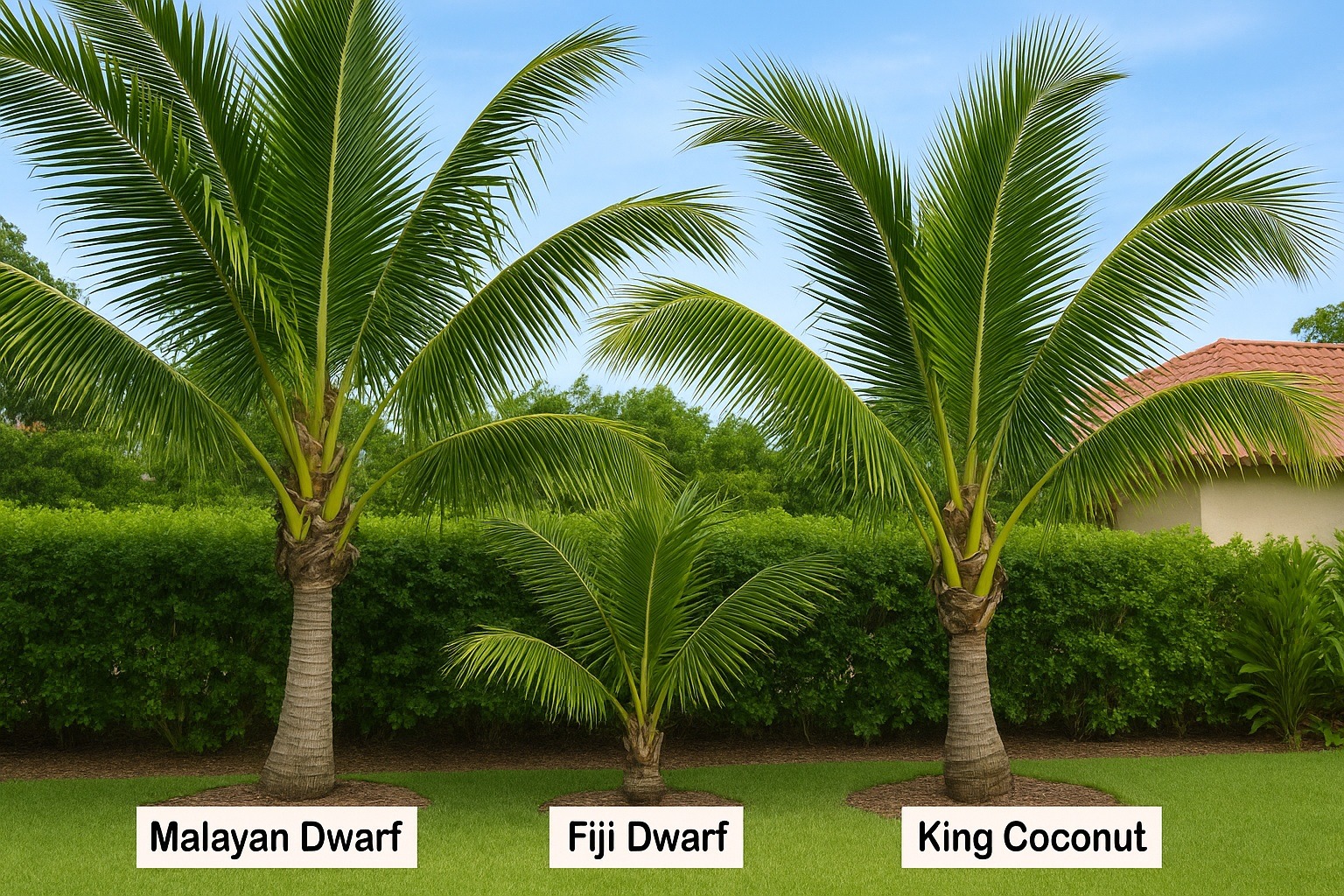
The most suitable coconut varieties for growing in home and garden environments are generally Dwarf types. These varieties are easier to cultivate in small spaces due to their shorter height (about 6–8 meters) and early fruit-bearing characteristics. Malayan Dwarf, Fiji Dwarf, and King Coconut are especially preferred in gardens with limited space or areas intended for decorative purposes. When properly maintained, these types provide both an aesthetically pleasing appearance and drinkable coconut water. Moreover, their shorter height makes the harvesting process safer and easier.
Another advantage of Dwarf varieties is that they are relatively suitable for growing in pots or large containers. Especially young seedlings can be grown for several years on terraces or balconies in large pots. However, for long-term growth and fruit production, it is recommended to plant them in open soil areas. Tall types, on the other hand, are not suitable for homes or small gardens due to their larger size and longer time required to bear fruit. For home landscaping projects, Dwarf coconut varieties are generally the most ideal choice in terms of both practicality and aesthetics.
How does the structure of coconut flesh vary by variety?
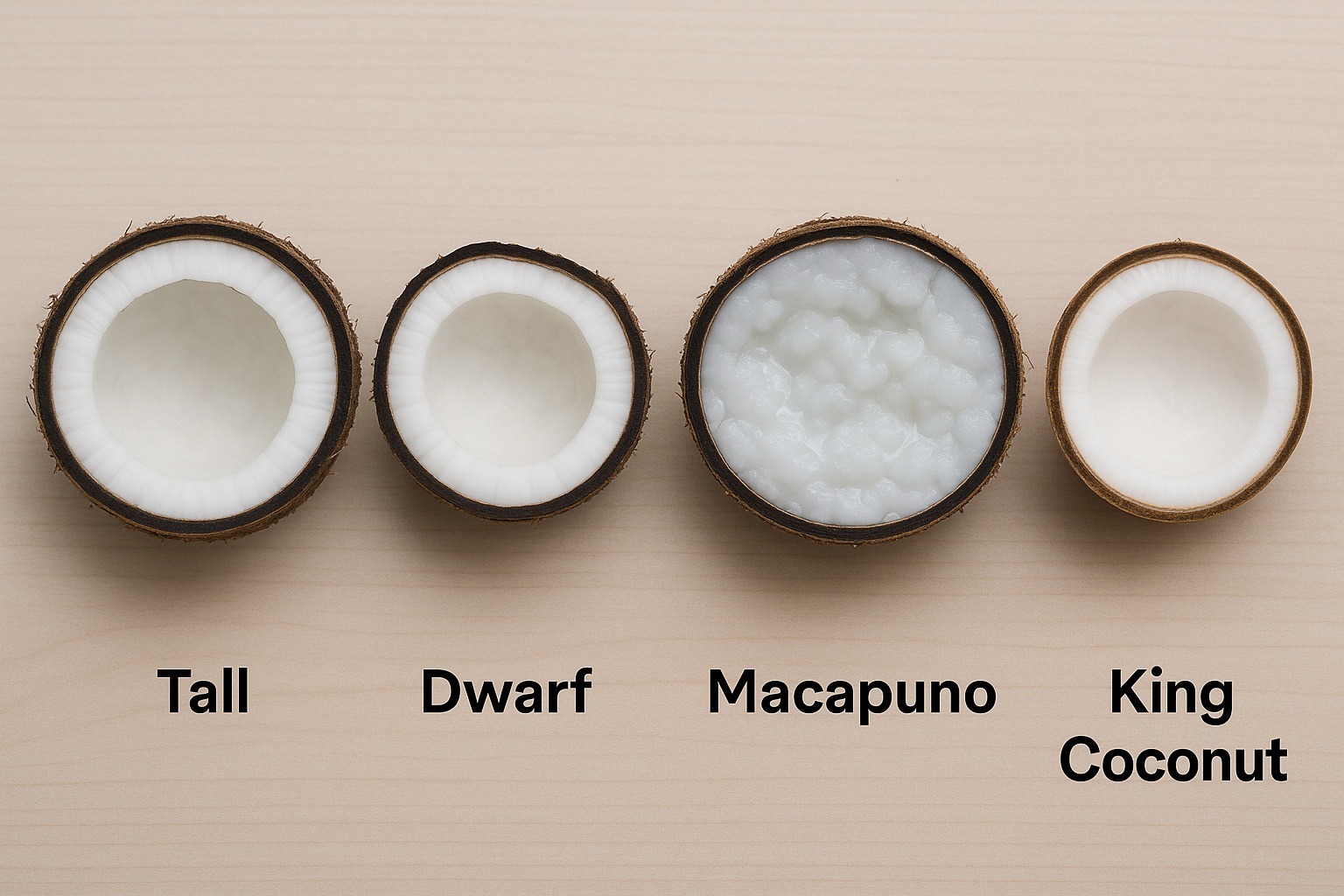
The structure of coconut flesh varies significantly depending on the variety and the degree of fruit maturity. In general, Tall types have thicker, more fibrous, and harder flesh. As these types mature, their flesh becomes firmer and is especially preferred for drying to produce oil or for grating to use in cooking. For example, varieties like West African Tall or Panama Tall are more suitable for industrial-scale production due to their dense and durable flesh texture. This type of flesh is usually drier and has a higher fat content, making it efficient for processed products.
In contrast, varieties like Dwarf and especially the special type Macapuno (Kopyor) have softer, juicier, and more gelatinous flesh. Macapuno, due to a natural mutation, has a nearly fully gelatinized flesh texture, and because of this structure, it is used in food products such as desserts and ice cream. King Coconut, on the other hand, is mostly focused on drinking water, so its flesh is very thin and generally not consumed. In Dwarf varieties, the flesh is of medium thickness, slightly sweet, and less fibrous; this makes it ideal for raw consumption or use in desserts. In short, each coconut variety serves different consumption purposes depending on its flesh thickness, consistency, and aroma.
